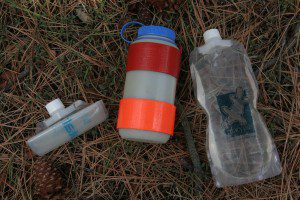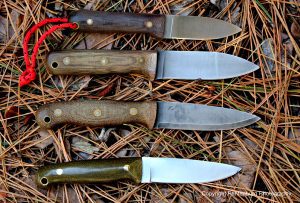

| Online: | |
| Visits: | |
| Stories: |

| Story Views | |
| Now: | |
| Last Hour: | |
| Last 24 Hours: | |
| Total: | |
Start with These Basics for Your Wilderness Survival Gear
You don’t have any wilderness experience, but you want some. So what do you take along to make sure you get back?
by Leon Pantenburg
One of the most common questions from wilderness newcomers is: “What gear will I need?”
And that’s a really good question! Walk through any sporting goods store and you’ll notice a bewildering array of gear, stuff, doo-dads, knick-nacks and junk. The buyer must decide which is which.
Depending on what store it is, and the salesperson, you could end up buying some very expensive – and unnecessary – items. In some stores, the salespeople work on commission and push high-priced gear. Or you might end up with a clerk who is covering the counter for somebody at lunch.
So, here’s where to start. The Boy Scouts of America have been preaching the gospel of survival common sense for 100 years. Who actually coined the term “Ten Essentials” is probably unknown. But there is no question that a facsimile of this basic list is the basis of all emergency preparedness kits. Get your Ten Essentials first.
Here is a list of the Boy Scout Outdoor Essentials, and product suggestions. Check out the links for more info on any of the topics. Look at these ideas, and then decide what will work best for you.
- Knife: The best knife is up to your personal preference, but you must have some sort of cutting edge along. The only survival knife you have is the one you have along!
- First Aid kit: (A first aid kit should go along on every outing, even if you never use it.)
- Extra clothing: (This will depend, of course, on the climate, time of year and where you are. Clothing needs for my high desert area are much different than for those people in the tropics.)
- Rain gear: You have two choices for protection from the rain: rainsuit or poncho. I use both, depending on the circumstances. I hiked the John Muir Trail with a poncho for rain protection. It rained nine days straight! The poncho kept me dry, even though I was expending a lot of energy to hike. I prefer a rainsuit while hunting or fishing, because it won’t flap in the wind, and a rainsuit offers better protection while sitting or standing for long periods of time. Decide what’s best for your needs.
- Water bottle: Water is an absolute necessity. I generally carry a Nalgene or other rigid water bottle to drink out of. In my pack, I’ll carry several soft bottles to replenish my Nalgene. The soft bottle are protected in the pack, and

This combination works well. The rigid Nalgene in the middle is used for drinking and the Paltypus soft bottles store extra water.
when empty, can be rolled up. The softies weight virtually nothing, and take up hardly any space. And if you find a water source, and need to re-supply, you’ll have ample containers along.
Make sure to include some system of chemical purification or a water filter.
I’m not a big fan of the water bladder systems, for no really good reason, but they are great for kids because the drinking tube encourages drinking. (And the novelty of using a bladder water system will keep them well-hydrated until the newness wears off!)
- Flashlight or headlamp: (I field-dressed a deer shortly after darkness fell one evening, holding my mini-maglite in my teeth. It was pretty gross – talk about drooling on your gear…) Anyway, ever since that experience I carry a good headlamp. A headlamp leaves your hands free if you are spelunking, end up walking out to the car in the dark, scrambling over rocks etc. Besides, if the lamp is on your head, chances are less that it might be dropped and broken.)
- Trail food: This is another personal preference. I like to make most of my own, because of my inherent cheapness and a Depression-era mentality inherited from my Dad. But in all my packs, I have several Clif bars, some jerky, sardines, and hardtack. The gourmet food comes from the Dutch oven. The emergency food is fuel.
- Matches and firestarter or other methods of ignition – you should have several different types.
- Sun protection Sunscreen is an item that needs to be in every survival kit, regardless if you’re in the arctic or the tropics. I carry the tube type, because it is less messy to apply.
- Map and compass A GPS is also useful, but not without a map and compass! Always include spare batteries for your GPS!
This is the bare bones list, and you should expand and add categories to fit your individual needs. For example, my Ten Essentials includes some method of shelter, such as a tarp, trash bag, bivey sack etc., and I always carry at least 50 feet of parachute cord or light rope, and four aluminum tent stakes.
Neither the scouts, nor I, recommend including fishing gear as a survival tool! Many of the items, such as the knife, first aid kit and Clif bars, have multiple memberships in my different specialized survival kits. Another necessity is the proper size spare batteries for any device that is battery-powered. It’s a good idea to get battery-operated items that all use the same size.
Your outdoor essentials list can also vary seasonally. I always include a snow shovel and insulite pad on my winter showshoe treks.
My summer and winter extra clothing choices would also be different. An extra stocking cap is always a good thing to have along, but in the summer, a broad-brimmed hat for sun protection is a necessity.
Some items you shouldn’t cut costs on are boots or hiking shoes; a sleeping bag, and a reliable shelter.
Use this Outdoor Essentials list to form the basis for your own survival kit, then read and research to get new ideas. Your survival kit, if it’s anything like mine, will probably end up being an evolving project. After every outing, think about what you used, what you didn’t need, and what you wished you had. Then adjust accordingly.
The best survival kit or gear in the world is worthless if you don’t know how to use it, and just having a survival kit won’t save you. In fact, it might give you a false sense of confidence that could be deadly!
Start your wilderness preparation by reading a credible survival book, or taking a class from a competent instructor. Be wary of any survival-related internet blog or website. Just because someone has a website, doesn’t mean they know anything! Don’t get your survival training off a prime-time survival “reality” show.
Then practice with your equipment. Learn how to make a fire, or pitch your shelter in your backyard. Try out your sleeping bag on a chilly night on the deck to make sure it’s going to be warm enough. Make your mistakes at home, so you won’t in the backcountry, where a screw-up can kill you.
And let this be your mantra: “My survival kit won’t save me. My equipment or gear can’t save me. I will save me.” And include common sense with every outing!
Please click here to check out and subscribe to the SurvivalCommonSense.com YouTube channel, and here to subscribe to our email update – thanks!
Source: http://survivalcommonsense.com/start-with-these-basics-for-your-wilderness-survival-gear/




